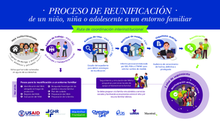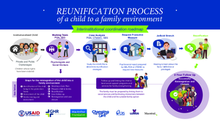Displaying 1271 - 1280 of 10391
Este gráfico está destinado a los profesionales que trabajan en los organismos gubernamentales y las organizaciones no gubernamentales que participan en diferentes aspectos del sistema de protección y atención, pero específicamente en el apoyo a la reunificación, y detalla las funciones y responsabilidades específicas de quienes participan en este proceso en Guatemala y cómo deben coordinarse.
This graphic is intended for use by professionals working within government agencies and non-governmental organizations in Guatemala engaged in different aspects of the protection and care system but specifically in support of reunification. It details specific roles and responsibilities of those engaged in this process in Guatemala and how they should coordinate.
In the BBC interview below, parent activist Taliah Drayak presents key findings from the report: Children’s Social Care: The Way Forward. She describes her family’s own nightmare when social workers removed her two-year-old from her custody.
The Toolkit for Community Child Protection Volunteers and supplementary training manual aim to promote evidence-informed best practices when engaging community volunteers in child protection responses. This toolkit is based on the Community Engagement in Case Management study, which was commissioned by the Alliance and completed in 2020.
Collaborating across humanitarian sectors is crucial to protecting children, promoting their well-being, and making the most of available funding. The CPMS Working Group’s “Working Across Sectors” initiative is gathering technical resources to help practitioners from all sectors achieve just that. The new Working Across Sectors Toolkit for Building Awareness and Support in English, Arabic, French and Spanish contains a wealth of ready-to-use materials for communicating the benefits of cross-sectoral collaboration.
This CELSIS briefing builds on the 2019 briefing, Access to Care Records, which outlined the legislative and policy context in Scotland around care records. This briefing is for all practitioners involved in writing, managing and/or supporting access to care records, and draws on research, campaigning work, and knowledge from organisations and local authorities across Scotland including in social work and information governance teams.
“Engaging Fathers – Putting Lessons Into Practice” is a three-part series to share strategies implemented from three of the five State or county agencies: Los Angeles county, California; Hartford, Connecticut; and Prowers county, Colorado. Part one focuses on the strategies developed within Hartford, Connecticut.
This report is based on consultations with parents and allies in England carried out by Parent Families and Allies Network; Love Barrow Families; New Beginnings; Parent and Carer Alliance; and Southwark Family Council and Parent to Parent Peer Advocacy. It sets out ideas on making the care system more supportive, humane and inclusive, and ensuring families’ needs are met early, with advocacy as a core feature. It also argues for immediate changes, led by parents and children with lived experience of social care.
Although long-term fostering has existed for many years as an important part of the foster care service, it was only in 2015 that the government issued the first regulations and guidance on longterm foster care. The introduction of these Department for Education regulations and guidance supports long-term foster care with both kinship and non-kinship carers as a positive permanence option. The aim of this study was to investigate their implementation.
This Lumos working paper examines the relationship between education and institutional care and the fact that many children – especially those who are most vulnerable – can only access education in residential settings, settings which share similar harmful characteristics with institutional care settings.








